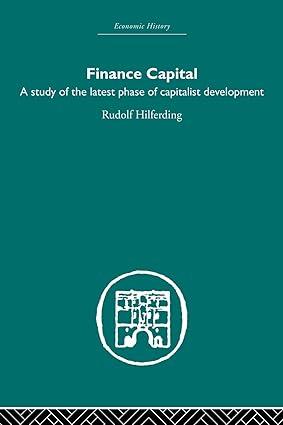Question
1) a. See page 11, first paragraph. What does it mean for ...the difference in means by insurance status [to be] contaminated by selection bias?
1) a. See page 11, first paragraph. What does it mean for "...the difference in means by insurance status [to be] contaminated by selection bias?"
b. See page 11, second paragraph. Why do the individuals with insurance in Table 1.1 have higher levels of health than those individuals without health insurance?
c. See page 11, third paragraph. What does it mean for "...the principle challenge facing masters of metrics is elimination of the selection bias that arises from ... unobserved differences."
d. See page 12, first paragraph. What does it mean to say, "Experimental random assignment eliminates selection bias."? In your own words, describe how an experiment with random assignment of subjects into control and treatment groups works to overcome the challenges brought about by unobserved factors that plagued the comparison of health outcomes by insurance status in the survey data in Table 1.1.
Table 1.1
| Husband | Wives | |||||
| Some HI (1) | No HI (2) | Difference (3) | Some HI (4) | No HI (5) | Difference (6) | |
| A. Health | ||||||
| Health index | 4.01 [0.93] | 3.70 [1.01] | 0.31 [0.03] | 4.02 [0.92] | 3.62 [1.01] | 0.39 [0.04] |
| B. Characteristic | ||||||
| Nonwhite | 0.16 | 0.17 | -0.01 (0.01) | 0.15 | 0.17 | -0.02 (0.01) |
| Age | 43.98 | 41.26 | 2.71 (0.29) | 42.24 | 39.62 | 2.62 (0.30) |
| Education | 14.31 | 11.56 | 2.74 (0.10) | 14.44 | 11.80 | 2.64 (0.11) |
| Family size | 3.50 | 3.98 | -0.47 (0.05) | 3.49 | 3.93 | -0.43 (0.05) |
| Employed | 0.92 | 0.85 | 0.07 (0.01) | 0.77 | 0.56 | 0.21 (0.02) |
| Family income | 106,467 | 45,656 | 60,810 (1,355) | 106,212 | 46,385 | 59,828 (1,406) |
| Sample size | 8,114 | 1,281 | 8,264 | 1,131 |
PAGE 11:
How do we know that the difference in means by in- surance status is contaminated by selection bias? We know because Y0i is shorthand for everything about person i re- lated to health, other than insurance status. The lower part of Table 1.1 documents important noninsurance differences be- tween the insured and uninsured, showing that ceteris isntparibus here in many ways. The insured in the NHIS are healthier for all sorts of reasons, including, perhaps, the causal effects of insurance. But the insured are also health- ier because they are more educated, among other things. To see why this matters, imagine a world in which the causal effect of insurance is zero (that is, = 0). Even in such a world, we should expect insured NHIS respondents to be healthier, simply because they are more educated, richer, and so on.
We wrap up this discussion by pointing out the subtle role played by information like that reported in panel B of Table 1.1. This panel shows that the groups being compared differ in ways that we can observe. As well see in the next chap- ter, if the only source of selection bias is a set of differences in characteristics that we can observe and measure, selection bias is (relatively) easy to fix. Suppose, for example, that the only source of selection bias in the insurance comparison is education. This bias is eliminated by focusing on samples of people with the same schooling, say, college graduates. Edu- cation is the same for insured and uninsured people in such a sample, because its the same for everyone in the sample.
The subtlety in Table 1.1 arises because when observed differences proliferate, so should our suspicions about un- observed differences. The fact that people with and without health insurance differ in many visible ways suggests that even were we to hold observed characteristics fixed, the uninsured would likely differ from the insured in ways we dont see (after all, the list of variables we can see is partly fortuitous). In other words, even in a sample consisting of insured and uninsured people with the same education, income, and employment sta- tus, the insured might have higher values of Y0i. The principal challenge facing masters of metrics is elimination of the selec- tion bias that arises from such unobserved differences.
PAGE 12:
Experimental random assignment eliminates selection bias. The logistics of a randomized experiment, sometimes called a randomized trial, can be complex, but the logic is simple. To study the effects of health insurance in a randomized trial, wed start with a sample of people who are currently uninsured. Wed then provide health insurance to a randomly chosen subset of this sample, and let the rest go to the emergency department if the need arises. Later, the health of the insured and uninsured groups can be compared. Random assignment makes this comparison ceteris paribus: groups insured and uninsured by random assignment differ only in their insurance status and any consequences that follow from it.
Step by Step Solution
There are 3 Steps involved in it
Step: 1

Get Instant Access to Expert-Tailored Solutions
See step-by-step solutions with expert insights and AI powered tools for academic success
Step: 2

Step: 3

Ace Your Homework with AI
Get the answers you need in no time with our AI-driven, step-by-step assistance
Get Started


